No.2  April 2009 April 2009 | ||
 |
Crop Prospects and Food Situation | |
|
Regional reviews
Harvesting of the 2009 winter cereal crops is due to start from June in most countries of the subregion. Crop prospects are generally favourable especially in Morocco, where further recovery in output from 2007 drought-reduced crop is expected, provided normal weather prevails in the coming months. Morocco’s aggregate wheat and barley area is estimated at about 5.1 million hectares, similar to last year and yields are expected to increase significantly pointing to a bumper crop this year. The outlook is also favourable in Egypt, the largest producer of the subregion, where weather conditions were also reported to be generally satisfactory and average to above-average cereal output is expected. By contrast, in Tunisia, in spite of government incentives to increase domestic production to mitigate the negative impact of high international prices on consumers, prospects remain uncertain. This is mainly a consequence of insufficient soil moisture at planting time, causing an area reduction. Although rainfall increased significantly in January and February, a strong agricultural recovery is not expected. In sum, FAO forecasts the aggregate output of wheat in the subregion in 2009 at some 17.9 million tonnes, 13 percent up from the previous year's level, while that of barley is put at about 5 million tonnes, an increase of 50 percent. An average cereal crop was gathered in 2008, which combined with a favourable crop prospects for 2009 and a significant decline in international commodity prices has been favourable in helping to reduce inflation and improve access to food. In Egypt, the most affected country, where the year-on-year rate of inflation in urban areas reached 23.6 percent in August 2008 (up from 6.9 percent in December 2007), a downward movement was observed from September with inflation dropping steeply to 14.3 in January 2009. Inflation is driven mainly by price changes in the food sector where the year-on-year rate of inflation dropped from 30.9 percent in August 2008 to 16.3 in January 2009. 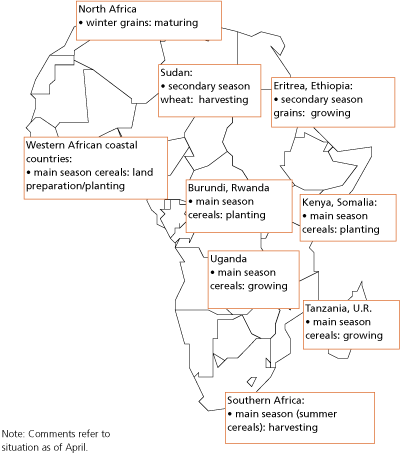
In West Africa, land preparation is underway in the Coastal countries for planting of the 2009 main season cereal crops, while in the Sahel, planting is scheduled for June.
Although a good cereal crop was gathered in most countries in 2008, the food security outlook remains a concern due to persisting high food prices. After having retreated for about two months during the harvesting period, prices of coarse grains which are driven mainly by regional supply and demand factors have been increasing since November-December 2008 in most countries. As a result, by February 2009, coarse grains prices remained well above the levels of a year ago. For example, in spite of significant decline from their peak of August-September 2008, wholesale prices of millet in markets of Mali (Bamako), Niger (Niamey) and Burkina Faso (Ouagadougou) in February 2009 were 16, 19 and 20 percent respectively higher than in February 2008. In Ghana (Accra), retail price of maize in March was 54 percent higher than one year earlier. However, retail prices of millet in Senegal (Dakar) in February 2009 were similar to their year-ago levels, suggesting that regional demand factor, notably demand from Nigerian food processing industries and poultry sector may be contributing to market tension in the eastern part of the subregion. The situation is not better for imported rice, whose price is determined by world prices and has exhibited high pass-through from the international market. In Burkina Faso, Senegal and Niger rice prices remain very high, being 60 percent, 48 percent and 41 percent higher respectively in February 2009 than a year earlier. By comparison, the export price of broken Thai rice in February 2009 was 22 percent lower than its year-ago level. Rice price inflation in francophone countries of Western Africa has been fuelled to some extent by the depreciation of the CFA (which is pegged to the Euro) against the US dollar since the beginning of the year. Similarly, the price of rice is likely to continue to increase in other countries of the subregion reflecting the steady depreciation of national currencies in response to the impact of the global economic crisis. In Nigeria, the Naira has depreciated steeply in recent weeks losing over 25 percent of its value between late November and January due to the impact of falling oil prices on the economy. And the Ghanaian Cedi has lost more than 30 percent of its value against the dollar in the past year. These developments are likely to translate into continuously high rice prices with negative impact on access to food, notably in import-dependent countries of the western part of the subregion. In several countries recent food prices are even higher than in 2005, the year of the last severe food crisis in the subregion, raising serious concerns over the food security outlook. However, while the 2005 crisis was triggered by a combination of locust infestation and poor rainfall which translated into severe crop and pastures losses, 2008 cropping season was characterised by good rainfall, record crop and abundant pastures in most countries. Hence, the impact of high food prices is likely to be strongest for rural food-deficit households and urban consumers. Therefore, safety net interventions, such as targeted distribution, sales at subsidized prices, food for work or cash for work activities, are recommended during the lean season, depending on the extent of food supply in specific areas. 
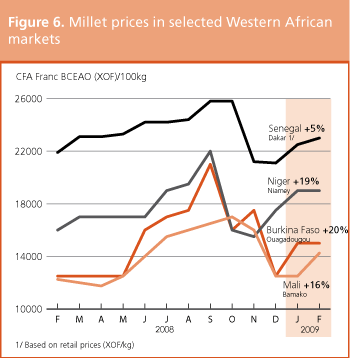

Planting of the 2009 cereal crops has just started. In Cameroon, although an above-average cereal harvest was gathered in 2008, cereal prices continue to rise driven by several factors including a strong recovery of the poultry industry, which was hard hit by Avian Influenza in 2006 as well as the dependence of the country on imported rice. In an attempt to control food inflation, the Government reportedly signed an agreement with traders in January to stabilise the price of imported staple goods, including rice. To compensate importers for the costs this policy may cause, the government has pledged to accelerate payment of tax credits and reduce handling fees. The agreement is scheduled to run through June 2009. Moreover, in the Central African Republic agricultural recovery continues to be hampered by persistent civil unrest and inadequate availability of agricultural inputs, notably in northern parts where nearly 300 000 people have reportedly been uprooted from their homes over the past two years. Continuing insecurity in both Chad and the Darfur region of Sudan threaten to further destabilize the situation in northern parts of the country.
The 2009 main season cereal crops are being planted and/or maturing in Somalia, Kenya, Uganda and Tanzania, while in Ethiopia, Eritrea and Sudan sowing of the main crops is not due to commence until late May-June. Late and below-average rainfall across the region since the beginning of the year delayed planting activities and negatively affected early planted crops, but abundant rains in late March and early April have improved prospects for this year’s cereal crops. In Kenya and Tanzania, crop performance this season is expected to improve following government initiatives to subsidise the costs of fertilisers and seeds. In the drought-affected pastoralist and marginal agricultural areas of southern Somalia, northern and north-eastern Kenya and eastern and south-eastern Ethiopia, the dry weather of the past months has raised cause for serious concern. Successive seasons of below average rainfall, combined with high input costs and civil conflict, have already affected crop and livestock production with devastating consequences on food security and livelihoods.
Harvesting of the 2008/09 secondary season crops is completed in most countries of the region, except in Ethiopia, where the “belg” crops are scheduled to be harvested from June. In Sudan, harvesting of the wheat crop is underway. The recently concluded “short rains” harvest in Kenya points to a decline in production due to poor rains, reduced area planted and high inputs costs. Estimates indicate that the short rains maize production reached only 130 000 tonnes, while the aggregate 2008/09 maize harvest totalled 2.34 million tonnes, 15 percent below the short-term average. The south-eastern marginal agricultural lowlands, which are highly dependent on the short-rains season, have been significantly affected by consecutive periods of poor rains. Similarly in Somalia poorly distributed and low levels of rainfall in combination with persistent civil insecurity and high input costs, resulted in reduced production for the 2008/09 “deyr” season. Total deyr production (sorghum and maize) was estimated at 54 000 tonnes, 54 percent lower than the post war average (1995-2007). In the United Republic of Tanzania, initial reports from the just completed 2008/09 “vuli” harvest indicate a reduced cereal crop on account of low seasonal rains across the north-eastern bimodal region. By contrast, preliminary estimates indicate an improved “second” season maize crop in Uganda of about 200 000 tonnes. The 2008 main cereal crops, harvested late last year, were good in the largest producers Ethiopia, and Sudan. However, in Eritrea, inadequate rainfall during the main “kremti” growing season resulted in a reduced harvest. In eastern Africa, the aggregate 2008 cereal production (main and secondary crop seasons) is estimated at 34.7 million tonnes, about 4 percent higher than in 2007. 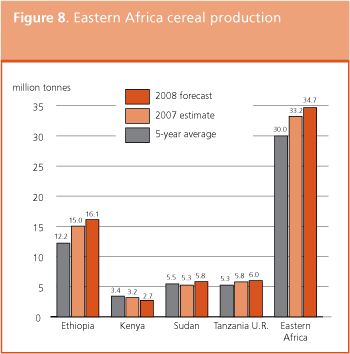
Despite some declines in recent months reflecting the harvest of the 2008 main cereal season, cereal prices in the region continue at high levels. A number of governments have removed domestic taxes and import duties on cereal sales in efforts to reduce prices. In Kenya, the price of maize, which reached record levels in February 2009 declined marginally in March to USD 381 per tonne in Nairobi, which is still 43 percent higher than in the previous year. In Somalia, the sorghum and imported rice prices have fallen in the past two months but by March 2009 they remained 72 and 32 percent higher than a year earlier. In Ethiopia, in Addis Ababa, the price of maize, the most widely consumed cereal, and that of sorghum, the main staple in most of the lowland areas of the country, began a declining trend since September 2008. This coincided with the harvest season, and by March 2009 the price of maize was only 4 percent higher than a year earlier while that of sorghum declined by about 6 percent. Similarly, the price of wheat, which is mainly consumed in urban centres, was 18 percent higher in February 2009, compared to the same period last year. In Uganda, the price of maize increased by 11 percent in March and is above the levels of March 2008. High regional demand for Uganda’s maize crop is expected to sustain the inflated domestic prices. By contrast, in Tanzania, maize prices fell in recent months and by March 2009 they were at the same level than a year earlier, although more than twice their levels of March 2007. 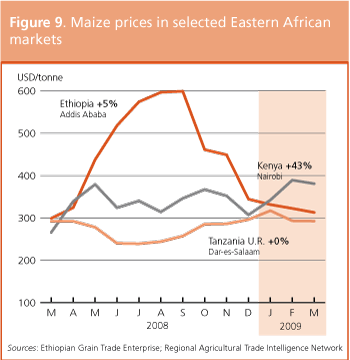
In Sudan, prices of sorghum, the main food staple, were 68 percent higher in February 2009 than prices recorded in the same period in 2008. By contrast, wheat prices in Khartoum, the largest consumption area, have decreased by 35 percent since February 2008. This decline exhibits a clear correlation to international price movements, on account of Sudan’s predominant reliance on imported wheat. In Djibouti, cereal prices have begun to decline since the beginning of 2009 with sorghum prices falling by 31 percent in January 2009 and the lower quality (belem) rice prices decreasing since October 2008. 
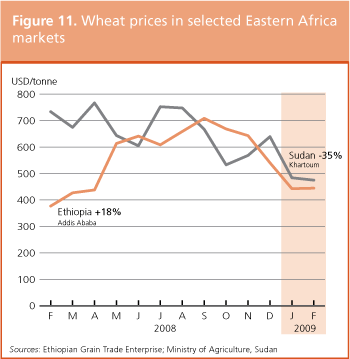
In Eritrea, the price of wheat flour and sorghum increased notably since February 2008 but has shown some stabilisation during January and February 2009, following the main harvest late last year. Between September 2008 and February 2009 the price of wheat flour, which is mostly imported, increased by 6 percent in the main port town of Massawa. Similarly, during the same period, the price of sorghum increased by 20 percent. This substantial price rise will significantly affect household’s purchasing power, negatively impacting on food security, particularly in rural areas where sorghum is the main staple. Furthermore, local prices converted to US dollars using the official exchange rate, are considerably higher as compared to regional neighbours. 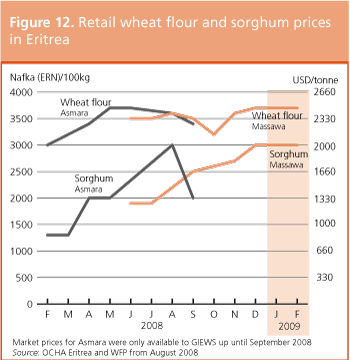
In Southern Africa, the 2008/09 cereal crops are being harvested or about to be harvested. Although the late arrival of seasonal rains in late 2008 caused some planting delays and subsequently a prolonged dry spell in February adversely affecting parts of the subregion, the outlook for the coming harvest remains generally favourable for the subregion as a whole. The seasonal rainfall pattern is illustrated in Figures 13, showing estimated rains in main growing areas of selected countries. However, the weather irregularities and reduced access to key inputs in some parts because of high prices have resulted in an anticipated decline in output. Latest indications point to aggregate production of coarse grains in 2009, 5 percent lower than last year but still above the average of the past five years. The area planted to commercial maize this season in South Africa is officially estimated at 2.42 million hectares, 13.5 percent down from last year, largely reflecting low SAFEX and international maize prices at planting time and delayed and poorly-distributed rainfall in the primary maize growing areas (the maize triangle). Output is tentatively forecast at 11.2 million tonnes, 12 percent down from last year’s record harvest. Large input subsidy schemes were again implemented in Zambia, Malawi, Angola and Madagascar enabling small farmers to use quality seed and fertilizer. This is expected to have a significant positive effect on their total cereal harvests. By contrast, a long dry spell of about 2 to 4 dekads in most areas in Zimbabwe coupled with shortages and high prices of key inputs such as fertilizer, seed, fuel, and tillage power will result in another low cereal harvest this year. The recently announced price and marketing reform, adoption of US dollar as local currency and liberalizing the grain market by making the GMB the buyer of last resort, arrived too late to have a significant impact on this year’s harvest. Erratic rains with prolonged dry weather also affected crops in southern parts of Mozambique and Angola where yields are anticipated to be reduced.
The pace of cereal imports into the deficit countries of the subregion in the current marketing year (2008/09) continues to be relatively slower than that of the past year (see Table 9), possibly due to the generally higher import prices during 2008/09, particularly for wheat and rice. Available figures by mid-March 2009, almost at the end of the marketing year, show that only 68 percent of estimated import requirements of all cereals (as opposed to some 82 percent the year before) have been received and/or contracted/pledged since the beginning of the marketing year in April 2008. In Zimbabwe, Mozambique, Angola and other countries actual imports have either fallen well-below the estimated import requirement or the data on deliveries is not yet complete. Given that the lean period has started as of January 2009, additional imports are urgently needed in order to avoid food shortages and further price hikes in local markets.
Prices of main cereals by March 2009 remained substantially higher than at the same time last year in some countries of the subregion reflecting delayed imports in marketing year 2009/09 (April/March in most cases). Prices of maize, the most important staple foodstuff in the subregion, were well above their corresponding levels a year earlier (see Figure 14). In South Africa, the region’s main exporting country, the March 2009 price (Randfontein spot in Rand) was 4 percent lower than at the beginning of the marketing year in May 2008, while during the same period a year earlier, prices increased by 13 percent. Prices in US dollars from May 2008 to March 2009 declined by 30 percent, reflecting the devaluation of the Rand. In Mozambique, the price in March 2009 (Maputo wholesale) of MZN 12.95 (Mozambique Metical) per kilogramme was 41 percent higher than for the corresponding month in 2008. Given that the new harvest has started in April, prices are likely to come down to their seasonal lows in most countries. The April 2007 to March 2008 average price of local rice, the main staple in Madagascar, was about 12 percent higher than the average for the same period a year earlier. These prices further increased by about 4 percent during 2008/09. Prices are expected to decline with the arrival of the new harvest starting in April-May. 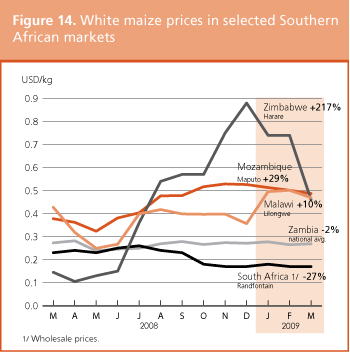

In China (Mainland), the winter wheat crop, which accounts for about 95 percent of China’s annual wheat production, is due for harvest in May-June. Following the severe winter drought, which seriously affected some 50 percent of the crop, beneficial rainfall during late February and March, coupled with increased irrigation supplies through government support, helped crops to recover. Above-normal temperatures during winter were also beneficial for crops. The 2009 wheat production is tentatively forecast at about 109 million tonnes, some 3 percent down from 2008 despite a slight increase in plantings. In India, the winter wheat crop is currently being harvested and 2009 output is officially forecast at 78 million tonnes, close to the last year’s record. Higher outputs are expected in Uttar Pradesh and West Bengal, while outputs in Haryana, Uttaranchal and Uttarakhand are likely to be the same as last year. The Government is expected to lift a ban on wheat exports after the April-May federal elections, reflecting the anticipated good production and record purchases of wheat due to higher state-set purchase prices (earlier this year, the Government increased the state-set price to INR 10 800/tonne from INR 10 000/tonne). India banned exports of wheat in 2007 to increase local supplies and prevent domestic prices from skyrocketing. The wheat crop, which is about to be harvested in Pakistan, remains in good condition due to favourable rains during the growing season. The 2009 wheat output is expected at a record level of 23.5 million tonnes. The Government has committed to maintaining the Minimum Guaranteed producer price of PKR 950/40 kg (or USD 11.8/40 kg) and wheat procurement target has been set at 6.5 million tonnes for 2009/2010. In the Islamic Republic of Iran, dry weather coupled with above-normal temperatures has accelerated winter grain development ahead of normal. The 2009 winter wheat crop is forecast to recover only partially from last year’s drought-reduced level. The country had become virtually self-sufficient in wheat in 2007, but following the 2008 drought the total wheat import requirement in 2008/09 (April/March) is forecast at 5.6 million tonnes.
Food staple prices have declined in the first quarter of the year, but they remain significantly higher in comparison to the long run averages in some countries. The price impact on overall food consumption to the vulnerable group of population is still high. In Sri Lanka, the retail rice price in Colombo declined to 61 Rupee/kg in March 2009, some 6 percent down from the previous month and 8 percent from the peak in June 2008. However, this price remains 78 percent over that of the same month two years ago. In Pakistan, the retail wheat flour price in Karachi was 26.3 rupee/kg in March 2009, 23 percent below the peak price in August 2008, but still 48 percent higher compared to that in March 2007. In Thailand, the wholesale rice (5% broken) in Bangkok declined to 18.27 Baht/kg in February 2009, 28 percent below that of the top level in April 2008, but still 74 percent above that in February 2007.
The 2008 paddy season in the subregion has concluded with much better results than earlier expected. The latest estimates point to a record output of 621.3 million tonnes of paddy in 2008, some 3.5 percent above the previous year. The 2009 paddy season is well advanced in some countries. Prospects are favourable in Indonesia (main season), China (early rice), Sri Lanka (Maha) and Bangladesh (boro ). By contrast, in Nepal, drought is adversely affecting the 2009 wheat crop, about to be harvested, and estimated crop losses are estimated at more than 30 percent of plantings in some areas. Precipitation and snowfall in the Far and Mid-Western districts during February, and in Central and Eastern Nepal during March, was too little too late to improve the crop situation. In many marginal agricultural areas of the Hill and Mountain districts of the Far- and Mid-Western regions crop losses are expected to be between 50 to 70 percent of the area planted. Several countries in the subregion have introduced new policies to support 2009 rice production. The Government of Thailand has set the farmers guaranteed price for second-crop paddy at the above market price level of THB 11 800 (USD 332) per tonne under a new intervention scheme starting on March 16 and running through July. The Government of Vietnam has asked major State- owned food business corporations to purchase all commercial rice from farmers and ensure them a profit of at least 30 percent. The country intends to export 3.4-3.5 million tonnes of rice in the first six months of this year and some 5 million tonnes in the whole of 2009, a level similar to last year. The Government of Bangladesh on 28 January 2009 introduced substantial reductions in fertilizer prices to boost farm production and keep commodity prices stable. Retail prices of three non-urea fertilizers -- triple super phosphate, murate of potash and diammonium phosphate -- were reduced by half.
Despite an overall satisfactory food supply situation in the subregion, vulnerable populations in a number of countries are still affected by serious food supply difficulties. The Democratic People’s Republic of Korea continues to suffer chronic food insecurity and remains reliant on external food assistance. However, the country has recently decided to stop accepting food assistance from the United States. The United States has delivered about 170 000 tonnes of food (mostly cereals) since May 2008. Food rations have reportedly been halved from April this year. In Nepal, rising food prices and failure of the 2009 wheat crop in localized areas have resulted in a significant increase in household food insecurity. Food security is also adversely affected by the financial crisis which has reduced the remittance income for many vulnerable households. In Myanmar, agricultural assistance continues to be needed for the 2009 secondary season and the next main monsoon season to help small farmers recover their production and livelihoods in the areas affected by cyclone Nargis (May 2008). Food shortages have been reported in Rakhine State, attributed to a poor agricultural season in 2007 and 2008, rising prices of food and agricultural inputs, as well as declining employment opportunities for the landless poor. In Sri Lanka, the country’s food security situation continues to be affected by the resurgence of civil conflict. Over 5 000 civilians have reportedly been killed and 220 000 people affected in crossfire between Tamil Tiger rebels and the government’s forces since January 2009.
The outlook for the 2009 winter wheat and barley crops to be harvested from May-June, are vastly improved over most of the subregion compared to last year, when extreme drought conditions decimated crops. Following dry spells earlier in the season, abundant precipitation during February and March were beneficial for vegetative winter grains in many growing areas, particularly in Turkey, Syrian Arab Republic and Lebanon. Satellite imagery has also indicated good rains in northern Iraq, benefiting jointing to early-heading winter wheat. In Israel, the danger of severe drought earlier this year was averted following heavy rainfall during late February early March. Similarly, in Jordan, rain showers in February, particularly heavy towards the end of the month have been very favourable for both crops and livestock. Last year’s poor cropping season led to reduced 2008 winter wheat crop production in most countries of the subregion (see Figure 19). The wheat crop in Iraq, estimated at 1.5 million tonnes, was some 36 percent lower than in 2007 and the smallest crop in recent history. In the Syrian Arab Republic, the total wheat production in 2008 is estimated at 2 million tonnes, half the poor crop harvested the previous year and well below average. 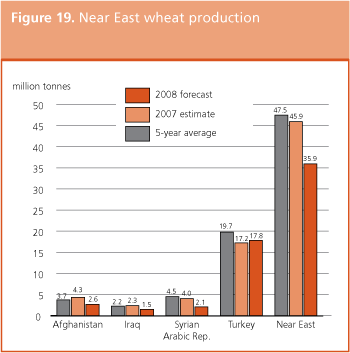
In Mexico, harvesting of mostly irrigated 2009 winter wheat crops is about to start in north-western states of Sonora and Baja California and in central state of Guanajuato. Planted area is officially estimated at 700 000 hectares and winter season production, accounting to about 95 percent of annual national output, is forecast at about 3.4 million tonnes. Harvesting of minor 2009 winter coarse grain crops has just started in the states of Sinaloa, Veracruz, Tamaulipas and Chiapas and, despite some localized losses due to reduced soil moisture, production is reported slightly above the good levels of 2008 and 2007 due to some increase in area planted. In Costa Rica, El Salvador, Guatemala, Honduras and Nicaragua, harvesting of 2008 second and third seasons maize and bean crops has been completed by the end of March. Despite various governmental programmes to support local production against the rise of international food prices, the 2008 aggregate maize production of the subregion (excluding Mexico) is now estimated at about 3.7 million tonnes, some 135 000 tonnes below the good output of 2007. This is some 200 000 tonnes below the previous forecast reflecting losses caused by intense precipitations at the end of last year that especially affected second season crops in northern Guatemala, the departments of Cortés, Olancho and Choluteca in Honduras and several lowland areas on the Pacific coast in Nicaragua. On the contrary, record production in 2008 maize, sorghum and paddy crops is reported for El Salvador, where precipitations have been abundant, timely and well distributed along the season, with general positive effects on yields. In Haiti, harvesting of small 2008 winter season crops of maize, beans and tubers has been completed by the end of Marchin irrigated lowland and humid mountains and production is estimated at average level. In aggregate, the 2008 production of main staple foods is reported to be some 10-15 percent below 2007 level as a consequence of crop losses caused by heavy precipitations during spring and fall seasons (which represent together between 65 and 75 of the annual output). Major losses were reported in the Southern Peninsula and the Artibonite valley where about 800 000 people are still receiving food assistance from the international community. The good performance of winter season crops, the reduction in local and international prices of food coupled with the implementation of Employment Intensive Investment Programmes in several departments have determined a certain decrease in the number of food insecure people from 3.3 million at the end of hurricane season to current 2.8 million. In the main growing states of Jalisco, Chiapas and Michoacan in Mexico and in other Central American and Caribbean countries, land is being prepared for planting the 2009 main summer/spring season maize and paddy crops, mainly rain-fed, by the beginning of May with the arrival of first precipitations.
In Costa Rica, El Salvador, Guatemala, Honduras and Nicaragua, nominal retail prices of rice registered an historical record level in September-October 2008, with a delay of a few months if compared to the peak reached in the international market. Since the beginning of 2009, national rice prices are showing first signs of a decline, but they still remain about 25-30 percent higher than one year ago. Wholesale prices of white maize have a more typical seasonal trend, with peaks in July/August during the hunger season before the arrival to markets of main season production and with minimum levels at the beginning of the year. This is essentially due to the fact that white maize, used to prepare important staple food tortillas, is almost entirely locally produced and its price is marginally influenced by international markets. In all countries, nominal prices of white maize in February 2009 are between 20 and 25 percent above the same month in 2008. An exception is El Salvador, where current maize prices have declined by about 7 per cent on one-year-basis as a consequence of the recent bumper crop. In Haiti, retail prices of main staple food are steadily declining with positive effects on households’ access to food; imported rice moved from record 72 gourdes per kg in August 2008 to 46 gourdes per kg in March 2009, almost the same level of 16 months before. 

Harvesting of 2009 main season coarse grain crops has started at the end of February and preliminary estimates indicate an aggregate production of 84.8 million tonnes. This result is about 16 percent below the 2008 record level as a consequence of the reduced planted area (-6 percent) and the prolonged drought that affected yields (-11 percent) in several key producing areas. In Argentina, maize production is forecast at 13.5 million tonnes, some 40 percent below the excellent output obtained in 2008 and 2007 and 28 percent below the five-year average. Scarce and erratic precipitations and hot temperatures until the end of January coupled with relatively high prices of inputs have delayed planting operations and often discouraged farmers to accomplish with their planting intentions. In the case of early planted varieties, February and March rainfall were somehow too late to determine a beneficial effect on yields, because most of the damage caused by the lack of soil moisture during crucial flowering and pollinating phases was already irreversible. In several cases, farmers have already decided to use their crops for pasture. This difficult situation is expected to reduce Argentina’s exportable surplus of maize in marketing year 2009/2010 (March/February) to only 7.5 million tonnes, about 60 per cent of the average volume traded in the last five years. A substantial decrease in maize production is also expected in Brazil where first season output is estimated at 33.7 million tonnes, some 15.7 percent below the record level of about 40 million tonnes obtained in 2008. Main losses in yields are reported in the key southern states of Paraná, Rio Grande do Sul and central and western zones of Santa Catarina, where monthly rainfall in November and December has been below 50 percent of normal. For example, in Paraná state, which accounts for almost a quarter of the national maize production, the drought lasted about 40 days and yields are currently forecast at only 4.7 tonnes/ha, well below the 2008 record level of 7.1 tonnes/ha. Regarding the recently planted 2009 second season (zafrinha) maize crop, despite the positive effects on yields of good weather conditions since January with abundant precipitations and above-average temperatures from northern Paraná to Mato Grosso, the official forecast points to a production of 17.6 million tonnes, almost 1.2 million tonnes below the 2008 record output. On the contrary, in Uruguay, despite the negative effects of the drought on yields, production for 2009 coarse grains is still expected to be record. This result is essentially due to a notable increase in area planted for maize and sorghum crops that, in aggregate, passed from 120 000 hectares in 2008 to 200 000 hectares in 2009. In Chile, harvesting of 2009 maize crop is well advanced and yields are forecast at a below-average level due to limited soil moisture and hot temperatures that, in several areas, have damaged the grain-filling process. Maize production is tentatively estimated at 1.25 million tonnes, some 10 percent less than the five-year average. Dry weather conditions are also reducing pasture availability in southern regions with consequent negative effects in meat and milk production. In Peru, planting of the 2009 yellow maize has been almost completed in the Andean department of San Martín and in northern coastal departments of La Libertad, Lambayeque, Lima and Piura, while harvesting of 2009 white maize crop for human consumption has just started. Total maize plantings for 2009 are tentatively expected to reach 500 000 hectares, very similar to the good acreage of 2007 and 2008. In Bolivia, harvesting of 2009 mainly rain-fed summer cereals is underway in main producing areas of Santa Cruz, Cochabamba, Chuquisaca and Tarija departments. Despite the good vegetation development observed from satellite imageries as a consequence of abundant and well distributed precipitations along the season, production of main food and cash crops has been hampered by the impossibility of farmers to fulfil their planting intentions due to the limited access to diesel at sowing time. To facilitate the imminent harvesting operations, the Government has recently issued a decree that allows small farmers to have free licenses to directly buy dieselfor their own consumption, up to 400 litres per person, until the end of August. In Venezuela, planting of the important 2009 winter maize crop will start in May with the arrival of first seasonal precipitations and planting intentions point to record 880 000 hectares (with both white and yellow varieties) that, under favourable weather conditions, may lead to the an unprecedented production of 3 million tonnes. Harvesting of 2009 paddy crop is underway in all southern countries of South America, while in Andean countries it is expected to start between the end of April and the beginning of May. Aggregate production is forecast at a record 24.4 million tonnes, some 2 percent above the previous record in 2008. 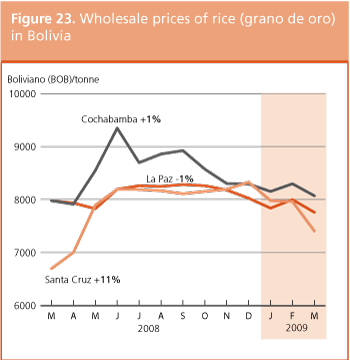
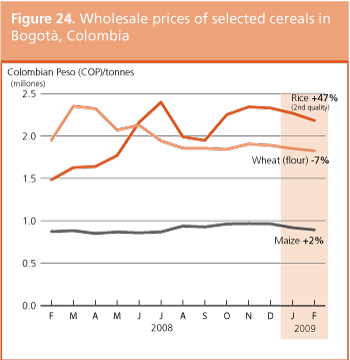
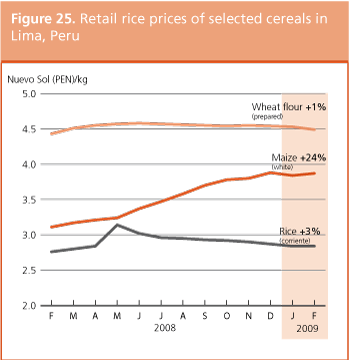
In the United States, the official Prospective Plantings Report issued at the end of March estimates winter wheat plantings at 17.4 million hectares, 7 percent down from the previous year’s level but slightly higher than earlier estimates. However, yield prospects are unfavourable in some important producing areas. Conditions for crops across the southern Plains deteriorated sharply in the early part of the year, and by early March, 64 percent of the crop in Texas was rated in poor to very poor condition and 46 and 15 percent respectively in Oklahoma and Kansas. For spring wheat (durum and other), planting of which has just started, the area is seen to decrease to about 6.4 million hectares, almost 7 percent down from the previous year’s level. Based on the official planting indications, and assuming normal weather for the remainder of the season, FAO currently forecasts the United States’ total wheat production in 2009 at 57 million tonnes, about 16 percent down from last year’s crop. The bulk of the maize planting in the United States is due to get underway in April. According to the Prospective Plantings Report, farmers are expected to further reduce the area of maize in 2009, but only slightly to 34.4 million hectares, after 34.8 million hectares planted in 2008. However, this remains a relatively high level. Moreover, as was the case last year, the area coming out of maize is expected to be the most marginal maize land, where better returns are expected from the cheaper to produce soybean crop, which is a surer option for farmers. In the 10 key maize producing states, where highest yields are generally achieved, the aggregate maize area is actually forecast to increase marginally compared to last year. Based on these early planting indications, and assuming normal weather for the remainder of the season, FAO forecasts the United States maize output at about 305 million tonnes in 2009, virtually unchanged from last year’s crop, which was the second highest on record. In Canada, planting of the spring grain crops is due to start in April. After the especially large crop last year plantings are expected to decrease this year. The wheat area is tentatively forecast to drop to about 9.2 million hectares from over 10 million in 2008, with farmers shifting land back to oilseeds. Assuming normal weather conditions and average yields, wheat production is forecast at about 24 million tonnes, down from the bumper 28.6 million tonnes in 2008 and below the average of the past five years.
Cereal production in the region is forecast to fall from last year’s good crop although output could remain above the average of the past five years. While assuming a return to normal yields after bumper levels last year, the expected decrease in output also reflects a reduction of area in response to the prospect of significantly lower prices for this year’s crops. At this early stage, the aggregate regional cereal output in 2009 is tentatively forecast at 462 million tonnes, 8 percent down from the previous year. In the EU, the total grain area for the 2009 harvest is expected to fall, following a shift to oilseeds and an increase in the area of land put back into voluntary set-aside. The total wheat area is estimated to be about 3 percent down from the previous year’s high level, and assuming yields don’t match last year’s record levels, production of wheat is forecast to fall to some 140 million tonnes, about 7 percent down from the previous year’s bumper level. In the European CIS countries, in the Russian Federation, although the winter wheat area is estimated slightly higher than last year’s, spring wheat plantings are forecast to decline significantly, by about 3 percent, as farmers planting decisions are expected to be influenced by the lower cereal prices and financial uncertainties. In the Ukraine, the wheat area is estimated to be down by about 500 000 hectares from last year’s high level and assuming a return to normal yields, a sharp reduction in output from last year’s bumper crop is expected.
In Australia, harvesting of the minor summer coarse grain crop (mostly sorghum) began in March and a satisfactory output is expected. Above-average summer rainfall benefited crop development leading to good yield prospects. Output of sorghum is forecast at some 2 million tonnes, well down from last year’s bumper output but about the average of the past five years. Early indications for the 2009 winter cereal crops, to be planted from April, point to a possible increase in sowings. Although international grain prices have fallen sharply compared to a year ago, a significant weakening of the Australian dollar compared to the US dollar means that prices for Australian producers in their local currency terms remain relatively attractive. However, although producers’ intentions may point to large plantings, the final outcome will depend on rainfall in the main growing areas from April through July. Good summer rains in key crop areas such as the north of New South Wales and Queensland auger well for the winter grain planting in these areas but the southeast remains adversely dry and good rains are desperately needed before sowing can begin. At this stage, based on the current indications of producers’ planting intentions and assuming normal weather for the season, the country’s wheat output in 2009 is tentatively forecast to increase by about 3 percent from last year’s level, to about 22 million tonnes, close to the record crop of 2003. A larger barley crop is also forecast. |
||||||||||||||||||||||||||||||||||||||||||||||||||||||||||||||||||||||||||||||||||||||||||||||||||||||||||||||||||||||||||||||||||||||||||||||||||||||||||||||||||||||||||||||||||||||||||||||||||||||||||||||||||||||||||||||||||||||||||||||||||||||||||||||||||||||||||||||||||||||||||||||||||||||||||||||||||||||||||||||||||||||||||||||||||||||||||||||||||||||||||||||||||||||||||||||||||||||||||||||||||||||||||||||||||||||||||||||||||||||||||||||||||||||||||||||||||||||||||||||||||||||||||||||||||||||||||||||||||||||||||||||||||||||||||||||||||||||||||||||||||||||||||||||||||||||||||||||||||||||||||||||||||||||||||||||||||||||||||||||||||||||||||||||||||||||||||||||||||||||||||||||||||||||||||||||||||||||||||||||||||||||||||||||||||||||||||||||||||||||||||||||||||||||||||||||||||||||||||||||||||||||||||||||||||||||||||||||||||||||||||||||||||||||||||||||||||||||||||||||||||||||||||||||||||||||||||||||||||||||||||||||||||||||||||||||||||||||||||||||||||||||||||||||||||||||||||||||||||||
| GIEWS | global information and early warning system on food and agriculture |